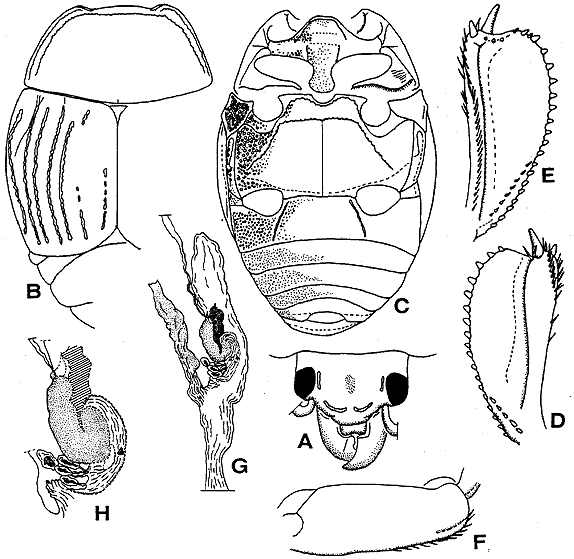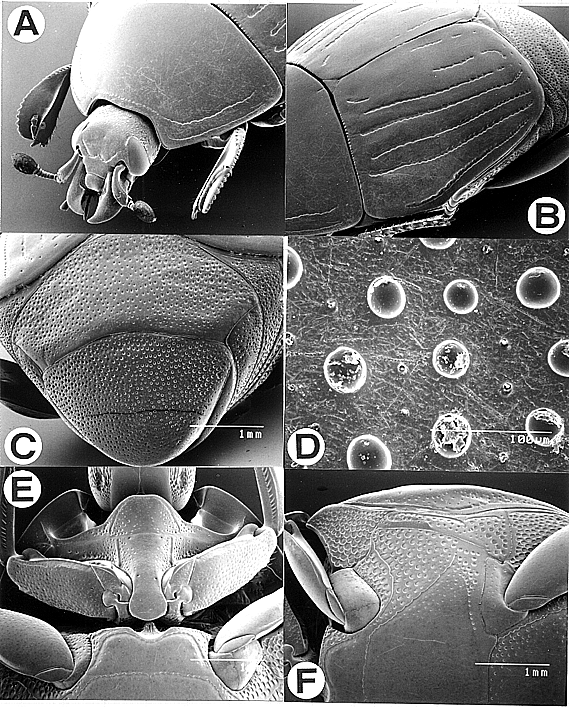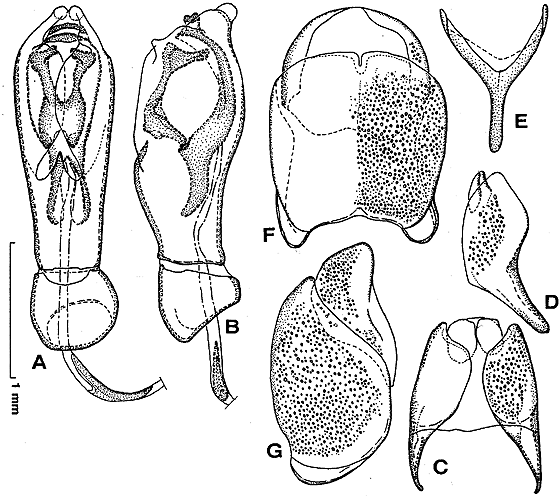Margarinotus (Ptomister) multidens (Schmidt,
1889)
Hister multidens Schmidt, 1889, 94 [Burma]; Lewis, 1915, 55.
Hister (Hister) multidens: Bickhardt, 1910, 46 [cataloged]; Bickhardt,
1913, 171 [Kosempo, Kaoshiung Hsien]; Desbordes, 1919, 391; Bickhardt,
1920, 98, 100; Miwa, 1931, 56 [Kôsenpô]; Kamiya and Takagi,
1938, 30; Reichardt & Kryzhanovskij, 1964, 172 [China, Kuatun, noted].
Margarinotus multidens: Wenzel, 1944, 126.
Margarinotus (Margarinotus) multidens: Kryzhanovskij & Reichardt,
1976, 341, f. 649, 672.
Margarinotus (Ptomister) multidens: Mazur, 1984, 167 [cataloged];
1997, 94.
Description (Ohara, 1999).
Body length, PPL, male, 5.9-7.8 mm, female, 6.8-8.6 mm, PEL, male, 4.95-6.1
mm, female, 5.4-6.7 mm. Width, male, 4.2-5.4 mm, female, 4.7-5.85 mm. Biometric
data are given in Table 4. Body oblong-oval, black and shining.
Frontal stria of head (Fig. 10A) deeply impressed, interrupted on each
lateral side and at middle, and strongly bent inwards at middle. Disk of
head sparsely and finely punctate, the punctures separated by about four
times their diameter. Vertex feebly depressed at middle. Labrum quadrate,
the anterior margin deeply depressed.
Marginal pronotal stria (Fig. 10B) broadly interrupted behind head, complete
laterally, often shortened on basal seventh. Inner lateral pronotal stria
nearly complete and strongly crenate, feebly sinuate laterally, sometimes
abbreviated on basal seventh, and its apical portion straight. Disk of pronotum
sparsely covered with fine punctures, which are separated by about four
or five times their diameter and become coarser laterally; area between
lateral striae with coarse and dense punctures, which are separated by their
own diameter to twice the diameter; a longitudinal puncture present in antescutellar
area.
Epipleural fossette strongly excavate, and sparsely and coarsely punctate.
Marginal elytral stria absent. Marginal epipleural stria complete and well
impressed. Elytra (Fig. 10B) with a slightly subapical transverse depression.
External subhumeral stria deeply impressed, with coarse punctures and shortened
at basal sixth. Internal subhumeral stria absent. Oblique humeral stria
present on basal third. First to 4th dorsal striae complete, 2nd usually
shortened at base and 4th at basal fourth; 5th dorsal stria present on apical
third and with a short basal rudiment. Sutural stria present on apical half
and usually interrupted. All striae, except the oblique humeral, moderately
crenate. Disk of elytra sparsely covered with fine punctures, which are
separated by three to ten times their diameter, and with subapical depression.
Pygidia (Fig. 11C) finely alutaceous. Propygidium densely and coarsely
punctate, the punctures separated by about twice their diameter and becoming
sparser medially, with a few minute punctures intermingled among the coarse
punctures. Disk of propygidium with a lateral depression behind each posterior
angle. Pygidium convex, its punctation similar to propygidial one, but a
little denser.
Prosternal lobe (Fig. 11E) broadly truncate anteriorly, its disk coarsely
punctate, the punctures becoming coarser laterally; marginal stria of lobe
completely and deeply impressed; carinal stria absent; inside area of lateral
prosternal stria coarsely punctate.
Anterior margin of mesosternum (Fig. 10C, 11E) deeply emarginate at middle,
its marginal stria complete and crenate; disk of mesosternum sparsely and
finely punctate, but the lateral third and an area behind each anterolateral
angle coarsely punctate; a short stria impressed behind each anterolateral
angle. Meso-metasternal suture complete and sparsely crenate, obtusely angulate
at middle. Post-metacoxal stria well impressed and regularly arcuate, its
ending attached at middle of metasternal-mesepimeral suture. Lateral mesosternal
stria (Fig. 11F) deeply impressed, crenate, extending posteriorly and obliquely,
and its apical end attaining to the peak of an elevation on lateral area
of mesosternum; oblique stria absent. Intercoxal disk of metasternum impunctate,
the area along the lateral stria sparsely and finely punctate, sometimes
densely covered with ocelloid punctures; lateral disk of metasternum densely
covered with ocelloid, shallow and large punctures, intermingled with moderate
ones; and without hair.
Intercoxal disk of 1st abdominal sternum coarsely punctate laterally
and well striate on each side.
Protibia (Fig. 10E, D) with 20 or 21 small denticles on external margin.
Profemur with posterior marginal stria on apical sixth.
Male genitalia as shown in Fig. 12. Aedeagus swollen on apical half;
ratio in length of paramera to basal piece 3.55.
Female genitalia as shown in Fig. 10G and H. Spermatheca consisting of
4 small sacs; basal tubular part coiled.
Specimens examined.
[Proper] Taipei Hsien: Chintienkang (1 ex., 27/viii/1994), Y.Y. Lien.
Taoyuan Hsien: Paling (1 ex., 11/viii/1989), native collector. Taichung
Hsien: Li-xiang (3 exs., 25/viii/1989), native collector. Nantou Hsien:
Shiztou, Puli (9 males, 8 females and 1 ex., 31/x/1987), K. Lah; ditto (2
exs., 5/v; 1 ex., 7/v; 1 ex., 5/xi/1989), native collector; Nanshanchi,
Puli (13 exs., 12-15/vi/1986; 1 male and 4 females, 12/viii/1989), M. Ohara;
ditto (3 females, 1/viii/1972; 1 female, 3/vi/1975; 5 males and 8 females,
9/vi/1976; 1 ex., no date), K. Masumoto; Sungkang (1 ex., 1/v/1973), S.
Tsuyuki; (1 ex., 17/vii/1983), K. Ra; Meiyuan (4 exs., 21/v/1981), Y. Chin-kin.
Taichung Hsien: Maliulu (1 male, 28/iv/1986), K. Masumoto. Kaohsiung Hsien:
Liukuei (2 exs., 12, 16/ix/1988), W. L. Chen; Tanghsi (1 female, 2/viii/1983),
W. L. Chen. ?: Wowanshan (3 exs., 10/x/1990), native collector.
[Continental China] Fukien, Kuatun (alt. 2,300 m), 27, 40n, Br, 117,
40o, L. (1 male, 9/x/1938), J. Klapperich.
Distribution. Taiwan; eastern India; Burma; continental China.
Remarks. This species belongs to the weymarni-group (Ohara, 1989).
Kryzhanovskij and Reichardt (1976) and Mazur (1984) noted Japan as a habitat
of this species, but their reports are erroneous. M. multidens is easily
distinguished from all the other members of the tribe Histerini by the number
of denticles of the protibia. It usually occurs under carcasses.

Fig. 10. Margarinotus (Ptomister) multidens (Schmidt). A: Head,
frontal view. B: Pronotum and left elytron. C: Ventral side of adult. D:
Left protibia, dorsal view. E: Ditto, ventral view. F: Left profemur, dorsal
view. G: Female genitalia, spermatheca, vagina and bursa copulatrix, lateral
view (left side). H: Spermatheca. [A-F: no. 9915, Liukei; G, H: no. 9919,
Nanshanxi].

Fig. 11. Margarinotus (Ptomister) multidens (Schmidt). A: Head
and pronotum, oblique view. B: Left elytron, oblique view. C: Propygidium
and pygidium, caudal view. D: Punctation of pygidium. E: Prosternum, ventral
view. F: Mesosternum, metasternum and epipleura of elytron, ventral view.
[AD: no. 9932, Shiztou, Puli; EF: no. 9938, Liukuei]. (Ohara,
1999).

Fig. 12. Margarinotus (Ptomister) multidens (Schmidt). Male genitalia.
A: Aedeagus, dorsal view. B: Ditto, lateral view. C: Ninth and 10th tergites,
dorsal view. D: Ditto, lateral view. E: Ninth sternum (spicule), dorsal
view. F: Eight tergite and sternum, dorsal view. G: Ditto, lateral view.
[no. 9914, Nanshanchi]. (Ohara, 1999).
Histeridae/Histerinae/Histerini/Margatinotus/References



